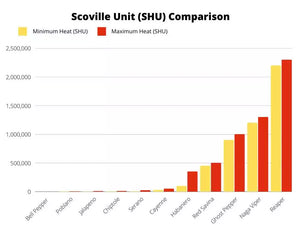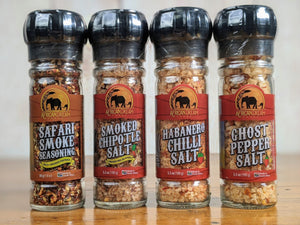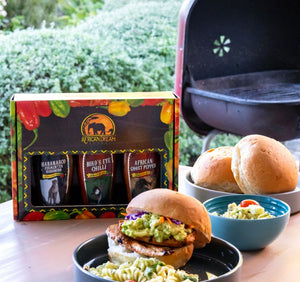What Is the Scoville Scale?
Mar 03, 2023
If you’re a fan of spicy foods, then you may have probably already heard the words “Scoville scale” being tossed around the dinner table. Unfortunately, not many people know what it means or how it relates to spicy food.
If you’re one of those people and you finally decided you want to learn more about it, then you’ve come to the right place. We’ll tell you all you need to know about the Scoville scale, from what it means to how accurate it is. So, let’s dive in, shall we?

What Is the Scoville Scale?
In simple words, the Scoville scale, also known as the pepper scale, is a rating index that shows how hot a pepper is by assigning a numerical value to it.
To put it even more simply, the Scoville scale tells you how spicy a certain pepper is, all the way from absolutely no heat to spiciness in the thousands and millions. As such, we can rank all hot peppers in order of their spiciness and know which peppers are okay to eat and which will just cause unimaginable pain.
How Did the Scoville Scale Come to Be and How Does It Work?
We have pharmacist Wilbur L. Scoville (1865-1942) to thank for the Scoville scale. In 1912, he was trying to create a heat-producing ointment, which needed chili peppers as one of its ingredients. That being so, he needed to determine how spicy each pepper he tested was, and that’s how he came up with what’s known as the Scoville Organoleptic Test.
Basically, the Scoville test/scale works by measuring the capsaicin content of a specific hot pepper. Capsaicin, in case you didn’t know, is the active component that gives chili peppers their kick.
It’s what sets your mouth on fire and makes you sweat and tear glands go into overdrive. Hell, it can even make your ears ache and have you coughing and spluttering.
As such, by figuring out how much capsaicin a pepper contains, you can know how spicy the pepper will taste in your mouth, and that concept is exactly what Wilbur Scoville applied in his work.
He started by getting a dried pepper and grinding it up. He then dissolved a certain amount of that ground-up pepper in alcohol to extract the pure capsaicin oil found in the pepper.
Wilbur proceeded to mix the oil obtained with certain concentrations of sugar water in order to see the dilution required to negate the effect of capsaicin on the tongue.
To do so, he used a team of taste testers, making them sip the alcohol extract/sugar-water mixture over a few days until the burning sensation in their mouth was gone or barely detectable.
Talk about being dedicated to the job!!!

Now, believe it or not, the same method is still being employed to see where hot peppers rank on the Scoville scale.
Basically, five trained taste testers are used to achieve the same thing, where they keep trying the different dilutions until at least 3 of the tasters stop feeling any heat coming off the mixture. Once that happens, they take that last dilution and use it to determine the heat level of the chili pepper under examination.
What Are Scoville Heat Units?
A Scoville Heat Unit is the individual measurement of the Scoville scale. To put it another way, Scoville heat units measure the number of times you need to dilute the capsaicin of a chili pepper with sugar water.
To make it easier to comprehend, let’s take a look at the Scoville Heat Units -SHU for short- of two peppers commonly found in today’s cuisines.
Say you’ve got a habanero pepper. On the Scoville scale, a habanero rates at 100,000–350,000 SHU. This means that you need to dilute this chili pepper from 100,000 to 350,000 times until it no longer makes your tongue burn.
Compare this to a jalapeño, which only needs to be diluted 2,500-8,000 until the heat is barely detectable, and you can imagine just how much spicier a habanero is.
So, as you can probably tell by now, the more Scoville Heat Units (SHU) a pepper has, the higher its Scoville rating and the spicier it is. The same applies to hot sauces as they also contain capsaicin and, therefore, can be assigned Scoville Units.
Is the Scoville Scale a Good Way of Measuring Spiciness?
Ah, yes. That’s the real question.
Now the Scoville scale has been around for more than 100 years, and to this day, it’s still the most widely used way to measure the spiciness of hot chili peppers or sauces.
However, it’s not the only one, nor is it the most accurate. In fact, different laboratories can have Scoville ratings vary by as much as 50%. I mean, that’s not exactly a small error margin!!!
So, why do the numbers vary so much even though the same procedure is done for every pepper? Keep reading, and you’ll discover just how flawed the Scoville. Organoleptic Test can be.
Why Is the Scoville Scale Not Accurate?

Unfortunately, the Scoville test has a lot of pits and falls. This ultimately renders its results inaccurate, and the Scoville scale ratings aren’t 100% true to form.
So, take a look at the weaknesses of the Scoville scale down below and see just how inaccurate it can be.
Human Subjectivity
You may have already guessed it, but human subjectivity plays a massive role in the inaccuracy of the Scoville scale.
As you know, no two people are the same, and as such, no two tongues are alike. What may seem extremely spicy to you can be just a little kick for your friend.
Therefore, since it’s an undeniable fact that variations in taste and spice tolerance exist, this, unfortunately, means that you can’t objectively determine when exactly the heat is gone. One taster may feel a sting, and another may not.
Now, the Scoville test does try to overcome this weakness by using a team of 5 tasters and going with the majority’s decision. However, that can only go so far.
Even trained taste testers will have different taste buds and spice resistances, which sadly means that the Scoville rating test can never be 100% accurate.
Sensory Fatigue
Now, not only is the original Scoville test inaccurate due to the subjectivity in taste but it can also be affected by what’s known as sensory fatigue.
Believe it or not, the human palate can actually become desensitized to the effect of capsaicin with just a few samples in quick succession.
You may have noticed this effect before when trying spicy foods. The first bite can be absolutely painful, but the rest end up being surprisingly okay.
Accordingly, if the Scoville test tasters keep sampling capsaicin extracts with no rest or rotation, they’ll eventually develop a tolerance to the spice, and the Scoville ratings will be skewed.
Pepper Variance
Just like people, chili peppers aren’t all the same. The same variety of peppers grown in one part of the world can widely differ from that grown in another. For example, our peppers are grown in South Africa which means our African Habanero has a completely different Scoville level than an American grown one.
Peppers, just like other fruits and vegetables, are influenced by the earth they’re grown in. The soil, humidity, and even the temperature are an example of some growing conditions that can alter a pepper’s heat level.
And it’s not just that. Things like the pepper’s seed lineage or maturity will also affect its pungency.
So, even if you know the Scoville rating of a ghost pepper in one place, it may not have the same rating in another. As such, you can’t really generalize the results of the Scoville rating test on all peppers.
Added Ingredients
This last weakness of the Scoville scale only affects the rating of hot sauces.
As you know, hot sauce bottles don’ts just contain pure pepper. They’ve got a variety of other ingredients like vinegar, garlic, and sugar to enhance the flavor of the sauce and make it more palatable.
But how exactly can these ingredients mess with the Scoville scale?
Well, say you’ve got a hot sauce, and you want to know its heat level. So, you take it to a lab, and they put the sauce through a dehydration process until a powder is obtained. This powder will then be tested using the Scoville method until its spiciness is determined.
Now, let’s say the sauce measured at 500,000 Scoville heat units. Unfortunately, this doesn’t reflect the true rating of the sauce.
During the dehydration process, the other ingredients evaporate, leaving only the capsaicin to be measured. However, in the hot sauce, these ingredients still exist, and they dilute the capsaicin.
So, in reality, the hot sauce will feel as if it’s much less hot than 500,000 SHU.
That isn’t even accounting for the fact that hot sauces are usually made of fresh peppers, which are basically 90% water. So, add the dilution from the water to the dilution from the other ingredients, and the final result will be far less spicy than the official Scoville rating.
Now some companies are aware of these dilutions, and they adjust their Scoville rating accordingly. However, others don’t take these dilutions into account.
So, if you find two companies saying different numbers for the same sauce, then the one with the lower number is probably much more accurate.
Are There Better Ways to Measure Spiciness?
As you already saw, the Scoville scale isn’t 100% precise. As such, scientists needed to come up with better methods for heat measurement, and that’s how High-performance liquid chromatography came to be.
Basically, high-performance liquid chromatography (HPLC) is a high-tech method of measuring chili pepper heat without the need for human tasters. While it also works by measuring the capsaicin content of a pepper, HPLC removes the inherent subjectivity of the Scoville test, leading to more accurate results all around.
Put simply, HPLC works by passing the capsaicin extract of peppers through a machine. This machine has several layers of absorbent materials through which the extract flows. By measuring the different flow rates and assigning them a pungency unit, you can determine the heat of any pepper.
Considering how hot some pepper varieties are nowadays, the HPLC is an absolute godsend for the taste testers of the Scoville test.
Honestly, nowadays, some of the hottest peppers in the world can have a Scoville rating in the millions. Can you imagine how painful it would be to taste one of those peppers?
So, it goes without saying that HPLC has made determining spiciness much easier. And best of all, you can convert the HPLC pungency units to fit the Scoville scale if you so desire, where one pungency unit equals 15 SHUs.
Usually, the conversion will lead to results 20% – 40% lower than the normal Scoville ratings, but these results are actually more accurate.
How Hot Are the Most Common Peppers According to the Scoville Scale?
Now, despite the fact that HPLC is more precise than the Scoville scale, the latter is still the most widely used method for heat measurement. So, it’s mighty useful to know where the peppers you like to eat are on the Scoville scale. Not only will you learn what your Scoville scale limits are, but you’ll also appreciate how hot some peppers can get.
So, here’s a small list of the most commonly known peppers and their Scoville ranking.
Carolina Reaper Pepper: 2.2 Million SHU (the official hottest pepper in the world)
Naga Viper: 1.3 million SHU
Bhut Jolokia (Ghost Pepper): 1 million SHU
Red Savina Pepper: 500,000 SHU
Habanero Pepper: 100,000–350,000 SHU
Cayenne Pepper: 30,000 – 50,000 SHU
Serrano Pepper: 6,000–23,000 SHU
Chipotle Pepper: 5,000–10,000 SHU
Jalapeño Pepper: 2,500–8,000
Poblano Pepper: 1,000–1,500
Bell Pepper: 0 SHU

How Much Scoville Heat Units Can a Human Handle?
As ridiculous as some of the Scoville ratings can be, is there a limit to how much a human can take? More specifically, can a human eat a Carolina Reaper and remain completely fine except for some body sweat and tears?
Well, if you’ve got chili pepper madness, you’ll be glad to know that the answer is YES!!!
Thankfully, the human body handles capsaicin pretty well. If a person ever eats an unhealthy amount, the kidney will quickly get rid of the excess capsaicin, leaving you none the worse for wear.
However, there is a limit to how much capsaicin you can eat before putting your body in danger.
A study done in 1980 stated that a dose of 13 grams of pure capsaicin can be lethal to a human weighing about 150 pounds. Another study demonstrated that a healthy person would have to consume about 2 quarts of Tabasco sauce before losing consciousness.
Now, since pure capsaicin can only be found in labs and no normal human would ever just drink two quarts of hot sauce, it’s safe to say that regular peppers, hot sauces, and even self-defense sprays have little chance of causing you any harm.
Yes, they may feel unbearably painful, but they’re not actually causing any damage. Still, if you ever feel that a certain type of pepper is too much for you to handle, it’s best you stay away from it.
However, if you want to build up your spice tolerance, then start with sauces you can easily handle, and then start incorporating the more challenging sauces into your diet. We suggest starting with our Mild Variety Pack and then working your way up.
And remember, don’t go overboard with the amount. All the extremely hot sauces are meant to be used in small dollops, so don’t overwhelm yourself and spare your tongue the torture.
Conclusion
Put plainly; the Scoville scale is the most popular choice when it comes to measuring hotness; however, it’s not the most accurate. Still, the Scoville scale is as accurate as we need it to be right now, and that’s why it’s still the measurement of choice.
So, if you’re a spice fan, it’s best you learn what the Scoville ratings are for your favourite pepper and hot sauces. And if you wish to learn more about anything genus-Capsicum-related, make sure to contact the Chile Pepper Institute in New Mexico.




